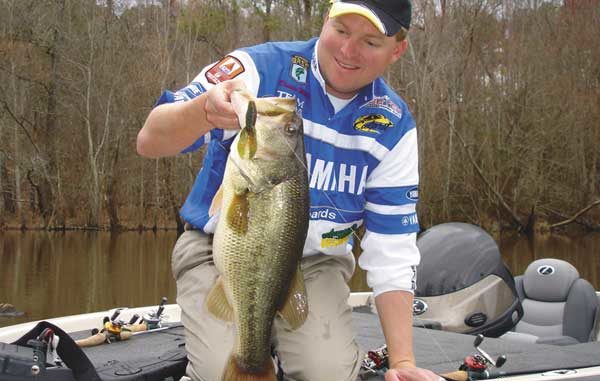
When fishing during the heart of summer, anglers must understand the thermocline and how it affects fish locations.
A thermocline is a layer of water where a rapid temperature change occurs. As the sun warms the surface layer, light penetration diminishes the farther down in the water column.
During this time, warmer water becomes less dense and “floats” to the surface while cooler water sinks.
Under the stable weather of North Carolina summers, a strong thermocline develops in lakes and ponds and can be a key to catching fish. Late in the summer, more and more of the oxygen below the thermocline is consumed and becomes uninhabitable to fish. The clearer and larger the body of water, the deeper the thermocline likely will be.
There are two ways to approach the emergence of thermoclines, as far as successful fishing tactics.
First, locate the thermocline and try to fish structure that intersects this depth. You can locate it with a temperature probe or with your depth-finder (with the sensitivity turned high).
The thermocline will appear as a thin line.
You also can idle offshore and note what level most of the shad are using and fish this level and above.
If the thermocline is 16-feet deep in a large reservoir, simply find structure at this depth and shallower and fish it. Large roadbeds are excellent places to try.
In smaller or murkier bodies of water, the thermocline is often much shallower. Small ponds can develop one at just 3 feet. If you‘re fishing below the thermocline in a pond, you’re just wasting your time.
Sometime fish will suspend off structure just above the thermocline level, making them difficult to catch offshore. The water depth may be 20 feet, but the fish are actually suspended at a much shallower depth.
One of my favorite techniques for catching suspended bass is ripping or “stroking” a jig. This involves finding likely structure with suspended fish.
Allow a jig to fall all the way to the bottom and rip it up off the bottom as high as you can. Hopefully, your jig will then travel up and out of the thermocline getting a reaction strike from suspended bass.
The first time I experimented with this was at Falls Lake, I caught 16 fish off one hump.
You’ll need a long stiff rod of at least 7 feet length to get the desired height on the “rip.”
I prefer Daiwa’s new Steez 7-foot, 1-inch rod with matching Steez reel because it’s so light and easy on your arms. I like at least a ½-ounce jig. I also “thin” the weedguard by removing several whole strands — not just shorting — but actually removing them.
Using long casts in deep water, you also need a soft weed guard to get a good hook set. Lighter wire hooks also help.
Sixteen-pound fluorocarbon has become my standard for this method because it stretches much less than monofilament. Some guys prefer braid with a short leader of fluorocarbon for even less stretch.
Yamaha Pro Dave Wolak of Wake Forest likes to concentrate at vertical cover when the thermocline is present.
“I really like bridge pilings or deep outer edges of a marina or dock,” he said. “I usually fish some type of Yum plastic with just a touch chartreuse dye added.
“I’ll just let it free fall down through the fish next to the pilings. When these thermoclines develop, many fish just suspend out in open water, but when some cover is present they tend to gravitate towards it.”
Wolak’s technique leads to the second way to approach the thermocline — fishing super shallow.
There are always going to be some bass shallow and often times they’re the easiest to target and the most aggressive. Instead of worrying about the thermocline in August, just fish shallow.
A jig also works well here, but one of my favorites has become the Culprit 3-inch Water Beetle. It’s a short, fat “creature” bait that penetrates shallow cover well and gets lots of bites.
Most of the time I’ll be making short side-armed casts or pitches to shallow heavy cover.
I like a 2/0 offset or wide-gap hook and vary the weight from 1/16 to 1 ¼ ounces, depending upon available cover and the fishes’ mood.
For matted vegetation, go all the way up to a 1 ¼-ounce weight to bust through the canopy to the open water below. For heavy cover, try pegging the weight with a rubber stopper (a toothpick will work, but you risk line damage).
My trolling motor is usually going extremely fast in the summer when I’m going shallow as I make casts into the cover — most of the bites come on the initial fall. I’ll fish it a couple of hops, then I’m off to the next target.
Many times bass will suspend within the cover, especially in weeds.
Remember the thermocline this August and don’t fish too deep!
A noteworthy sidebar for Eastern N.C. river fishermen is that saltwater is also more dense and the fresher water remains on the surface until mixing can occur further downstream or into the ocean.
In dry years, it’s important to fish shallow or more up river to be in fresh water. Smaller bass can handle a little more salinity than larger bass.
Dustin Wilks is a 30-year-old professional bass angler and Raleigh native now living in Rocky Mount. He has qualified for the Bassmaster Classic four times and operates Fish Like a Pro Fishing Lessons (252-883-6749 www.fishlikeapro.com ). His sponsors include Skeeter Boats, Yamaha, Daiwa, Keelshield and Culprit.



Be the first to comment